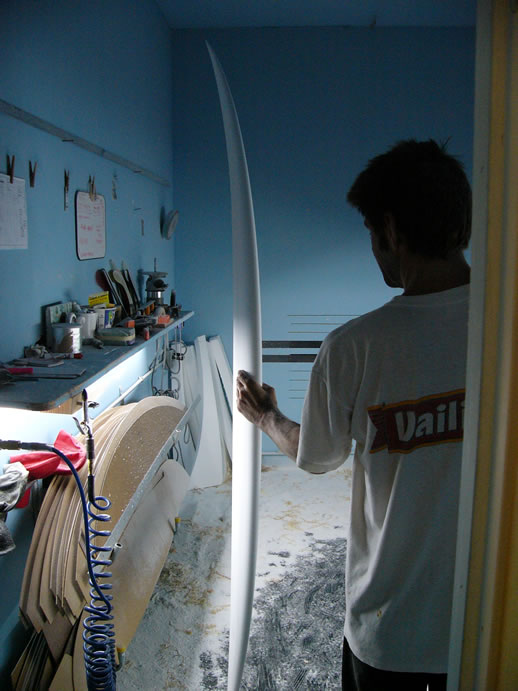|
EPS Epoxy Foam Core Surfboards… Are they the future?
Here’s the deal, the closing of Clark Foam on Monday, December 5th 2005 is relatively old news. The initial panic drove up board prices and caused surf shop owners to order large quantities of boards from overseas.
Since then, new foam sources have emerged and alternative materials have been revived. There is foam available but nothing like before. Some local manufacturers have started production and there are imports coming in from South Africa, Australia, etc. However, the days of custom blanks are over for now. Then there are others have moved on to different materials.
Historically, the surf industry community resists changes in the materials used in making surfboards. There are better materials available but tend to be more expensive and labor intensive.
Most large surfboard manufacturers make most of their boards from polyurethane blanks (cores). In order to produce large quantities of boards, these manufacturers use in house or outside CNC machining to rough cut the blanks then have hired shapers fine finish the boards. Then there are the composite molded technology surfboards which are either foreign or domestically made. However, custom made surfboards are still preferred by surfers because composite molded boards tend to feel lifeless.
Recently Channel Islands Surfboards announced it signed an agreement for Burton Snowboards to acquire its assets. Channel Islands Surfboards is probably the largest single label surfboard manufacturer and produces in the range of 2000 boards a month. Burton Snowboards is the largest snowboard manufacturer with a great distribution network. However, with the increase in available capitol and manufacturing capabilities from Burton we could see new quality surfboards with new materials in the near future. Hopefully, we don't get massed produced boards for those who really can’t tell the difference between a good board and one with a popular logo.
We, at ProSurfing.com, prefer to support the real artists of the surf industry. The guys who actually hand shape custom surfboards for the surfer.
I recently met with Tim Stamps of Stamps Surfboards to discuss what my options were for my first board since the closure of Clark Foam. I’ve known Tim for a long time and he knows how I surf. Tim has shaped several boards for me and I couldn’t be more pleased. With limited polyurethane blank options, Tim recommended trying an EPS (expanded polystyrene) core blank. He has invested a lot of time and effort to develop his EPS skills to take him into the future. Check out the photo essay of my first Stamps EPS Epoxy surfboard.
EPS surfboards are glassed using epoxy resin and are lighter, stronger, more buoyant, and have better heat resistant characteristics than traditional boards. I tend to destroy polyurethane surfboards but I really like the flex pattern and feel under my feet.
I have never ridden an EPS board and was hesitant at first because I have heard that they feel rigid, tend to float too high in the water and are hard on the bottom of your feet. We reduced the overall volume to compensate for the increased buoyancy and I may have to get a tail patch for my back foot. EPS surfboards materials are more expensive and there is a lot more work for both the shaping and glassing process. Tim actually makes his own blanks from a solid block of EPS foam. Thus, the final cost of the board is higher than a traditional board but if it works well and lasts longer... it will be worth the extra money.
Check back soon for my full review of my first EPS surfboard. It’s at the glass shop. “Is my board done yet?”
Get your own custom board from Tim Stamps Surfboards, you'll be Happy you did.
Jason Hennessey
ProSurfing.com
Go to the follow up article and see how it rides.
|
